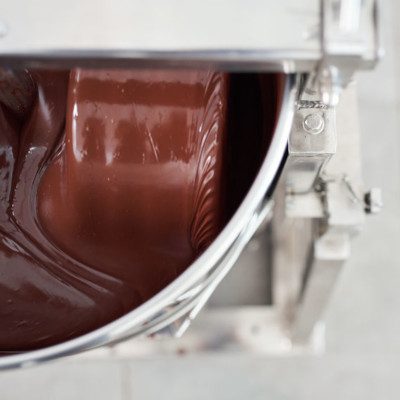Typical batter composition
| Ingredient | Baker’s % |
| Cake flour | 100.0 |
| Fat | 40.0–50.0 |
| Sugar | >100.0 (high-ratio cakes)
<100.0 (low-ratio cakes) |
| Total hydration (from liquid whole eggs and water) | 100.0–130.0* |
| Baking powder | 1.0–5.0 |
Application
There are several batter mixing methods used in the production of cakes. The most relevant ones include:
- Single stage (all-in)
- Multi-stage
- Creaming
- Blending
- Continuous
Each mixing method has its own specifications, advantages and disadvantages. The following table summarizes these methods:1
The following table summarizes these methods:1
| Single stage | Multi-stage | Creaming | Blending | Continuous | |
| Processing (order of ingredient addition) |
|
|
|
|
|
| Advantages | Labor savings
Shorter mixing time Quick and simple processing Versatile system |
All dry materials are handled in one stage
Reduces the chance of lumps of flour and/or shortening |
Excellent aeration of batter
Better volume Finer cells when emulsifiers are not available Best option if volume is the primary goal |
Increased cake tenderness (gluten development is limited by fat coating)
Able to use stronger and higher protein flours Best option if tenderness and mouthfeel are the primary goal |
Widely used in high-speed operations
Labor savings Automated processing (air injection, temperature, dwell time, production rate) Real-time control of SG |
| Disadvantages | Long mixing times
Higher changes of scaling errors Curdling risks (phase separation) due to liquids being added to quickly |
Long mixing times | Long mixing times | High capital costs |
Undermixing effect on batter (high specific gravity):2
| Batter | Finished Product |
|
|
Overmixing effect on batter (low specific gravity):2
| Batter | Finished Product |
|
|
Batter mixing equipment
Batters can be mixed with the same equipment used for bread dough mixing (e.g. vertical mixer, spiral mixer). The only change that is needed is the attachment or beater. Instead of an arm or hook (used to developed gluten), a wire whip and/or paddle are used. These provide a blending and stirring pattern that provide the correct mixing conditions to create the batter.
Mixing time of batter is governed by the extent of air incorporation (aeration). Reaching a given specific gravity (SG) during mixing takes time, and each type of cake requires a batter with a unique SG or aeration level.
Batter temperature after mixing should be in the range of 68–72°F (20–22°C). Cold batter temperatures are very helpful during batter mixing for 2 reasons:
- Lower temperatures provide stability to the batter emulsion by increasing viscosity (shortening becomes thicker at lower temperatures). Higher viscosities create more resistance to the movement of gas bubbles trying to escape from the batter system.
- Lower temperatures increase the solubility of gases dissolved in the batter (according to Henry’s Law). This helps retain gas bubbles as much as possible (both air and carbon dioxide released from chemical leavening reactions).
As a general rule, the higher the rotation speed, the faster and greater the aeration. Higher RPM can be used to achieve a certain SG value in a shorter mixing time.
References
- Tireki, S. “Technology of Cake Production.” Food Engineering Aspects of Baking Sweet Goods, CRC Press Taylor & Francis Group, LLC, 2008, pp. 149–155.
- Bennion, E.B., and Bamford, G.S.T. “Cake-making Processes.” The Technology of Cake Making, 6th edition, Springer Science+Business Media Dordrecht, 1997, pp. 251–260.

